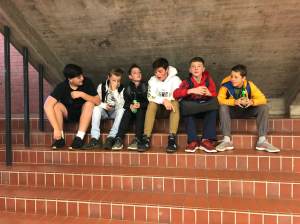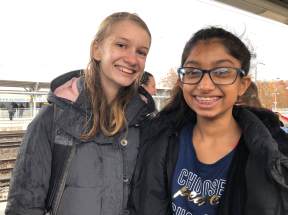Project-based learning
Design Thinking in Middle School: A Human-Centered Approach to 21st Century Learning Vision
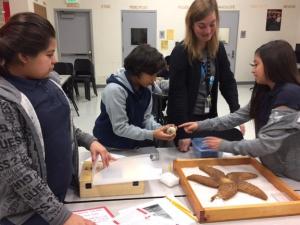
Technology advances at a rapid pace. So fast that it often outpaces advancements in education policy and practice. Students are often way ahead of the curve while teachers who learned pedagogical methods in days when there were many less avenues for incorporating technology into classrooms lag far behind them in terms of technological facility. This is compounded by the fact that every student learns in a different way, and with more and more options, it gets increasingly difficult to cater to the individual needs of students. This is what makes the Design Thinking in Middle School: A Human-Centered Approach to 21st Century Learning Vision project really stand out. They aim to bolster the technological aptitude of their educators while designing more individualized curriculum for their students. In pursuit of this vision for student learning, a team of teachers at Southeast Middle School applied with their Board of Education to open a magnet center on campus. The focus of this magnet center is to bring a three “I” – Interest, Impact, and Innovation- driven approach to teaching and learning.
Goals
In order to better understand where they find themselves as of their last progress report, it’s important to understand the goals they set out to accomplish.
Students will work on collaborative, cross-curricular projects that center on design thinking, a powerful learning tool that teaches students to use empathy and critical thinking to tackle problems of any kind from a human-centered point of view. In their model, the teacher’s role is to provide opportunities for discovery and to guide students to understanding through their innovation projects. The transition from a teacher-centered, depository learning framework to a student-centered, design-based learning approach requires teachers to work in a highly collaborative environment to develop cross-curricular and student-centered projects.
So, in their first year, how did they go about doing this?
Before they could start they had to answer a few key questions for themselves, and anyone looking to replicate this program would do well to do the same.
- What resources are currently available and/or necessary to obtain in order to successfully realize their stated vision?
- How might the concepts learned in the theme-based professional development activities be applied to their specific school context?
- What effect(s) might a design thinking approach to teaching and learning have on school performance, as measured by five instructional pillars (teaching) and the ISTE 21st century skill standards (learning)?
These questions guided their approach and the following methods were applied.
- Conduct a needs assessment and establish a teacher growth plan,
- Plan and implement teacher developed lessons tailored to the classroom context, and
- Evaluate the impact of the project on student learning and extract teacher learning through reflective practices.
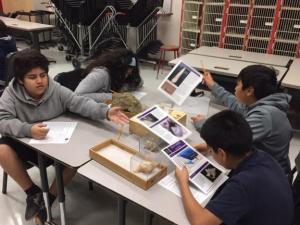
Their first year found its focus in the first two milestones. One of their priorities this year was to help the new magnet teachers build a theoretical grounding in the foundations of design thinking in K-12 education. They found early on in the project that this looked different for every teacher, based on their subject area, experience level, and their personal interests in areas of growth. Because of these disparate levels of experience, as a team, they decided that more experienced teachers would take on a more robust menu of learning opportunities that were designed to fill in gaps in theoretical and clinical knowledge and to prepare themselves to be teacher leaders in the new school. Their primary learning focus as a teacher leader team was to increase their capacity to understand and teach in alignment with a program theme of design thinking through project-based learning.
So, a year in, where are they?
Their collection of professional development opportunities during Year One has helped teachers develop a greater capacity for executing the magnet program’s vision of developing a human-centered approach to 21st century learning. Teacher leaders are using their learnings from model school visits, workshop and trainings, and collaborative planning sessions, to develop a comprehensive instructional technology plan, to plan and implement theme-based lessons tailored to their classroom contexts, and to develop a comprehensive introductory professional development plan for novice teachers. This included the teacher leaders themselves sharing their learnings through professional development sessions that they curated from their experiences in Year One of the project.
Students were able to develop their skills as digital citizens, innovative designers, knowledge constructors, creative communicators, empowered learners, and global collaborators through design-based, project-based learning tasks throughout the school year. Additionally, they were able to showcase their learning at multiple community events at their school site and within the larger learning community of South Gate. News and pictures of the events were shared on the school website at <http://southeastms-lausdca.schoolloop.com/>. Teacher-leaders are currently designing their digital portfolios to showcase their student projects on the magnet program website <www.dreamsmagnet.org>.
But no project is without challenges. What were some that they faced?
The biggest thing they had to contend with was finding substitute teachers within the budget. This allowed the participating educators to take time off from class for professional development. This is being solved in the second year by reallocating some of the grant money to pay for that.
It’s never too late to educate yourself on the latest technology. Even though chances are, by the time you’ve mastered it there will be something new. But that shouldn’t stop us from trying to narrow the technology gap between students and educators, and this project sounds like one way to do it.
Further reading
Full STEAM Ahead with Project Based Learning
All aboard and Full STEAM Ahead!
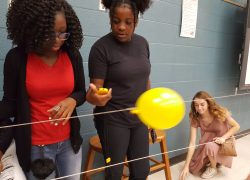
The educators over at Bates Middle School in Sumter, South Carolina have been working hard laying tracks for the past year in order to bring their exciting project to fruition. By combining Project Based Learning (PBL) and a curriculum focus on Science, Technology, Engineering, the Arts and Mathematics (STEAM) and working with local businesses they are hoping to create a new generation of students who are prepared to be in an agile and competitive work force. One of the brilliant concepts behind this project is that nothing exists in a vacuum. You can’t well understand engineering if you don’t have a good handle on physics. You can’t code a videogame without understanding the underlying code. And you certainly can’t have music without math.
The Full STEAM Ahead project aims to remove the traditional isolation of subjects through the use of the “Critical C’s” of Collaboration, Cooperation and Communication which are emphasized with project based learning through interdisciplinary activities.
Now that they are a year in, let’s see what has transpired.
Bates teachers, led by the Transforming Learning Together (TLT)
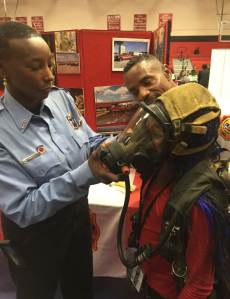
mentor teachers, in the first stage of this initiative begun by identifying large-scale student learning goals for the year. They then researched new teaching approaches in order to integrate STEAM and Project Based Learning to help them achieve their goals, along with developing “action plans” for each year’s practice. The belief was that art can spark creativity in young scientists and engineers, develop observational abilities, and strengthen collaborative skills. One of the guiding questions for this project is ” How can we improve instruction, pedagogy, and student learning across the curriculum through the use of STEAM and PBL?”
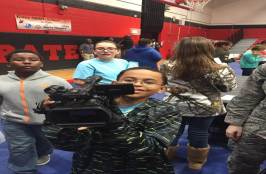
So how do they propose to do this?
They began by having their trainers and the TLT team attend a PBL and STEAM workshop that spaned six sessions. This team returned to Bates to lead the entire staff through a STEAM Project Based Learning activity in order to familiarize everyone with the methods. Teachers investigated and utilized critical inquiry to work through this challenge. The thinking was that teachers will experience everything that the students do, giving them the tools to help elevate the projects as well as answer previously unanticipated questions. Teachers then guided students through one PBL unit in the first year of implementation.
A year in… where are they now?
They started off by providing professional development to their teachers during the first semester of the school year. STEAM lessons were developed to be a part of the regular curricula as well as embedded in Project Based Learning. The second semester brought about school-wide PBL units. Then on March 24th, there was a school-wide PBL Kickoff to begin the grade level units. This is where things really began to take off. For this initial thrust into the unknown they gave each year a different subject field to dig into. Sixth graders explored the guiding question: “Are animals placed in captivity at an advantage or disadvantage than those in their natural habit? Why/ Why not?”

The kick-off was a field trip to the Riverbanks Zoo. The 6th graders researched the question and created suitable habitats for animals of their choice. The 7th graders explored the guiding question: “How can we be prepared for the unexpected?” Dealing with the preparedness for natural or man-made disasters was the focal point. The Red Cross, Fire Department, EMS, Disaster Management, Police Department, Shaw AFB and Salvation Army each set up a station to explain their role in disasters and how the community can prepare for disasters in the future. Students researched a disaster and prepared community service presentations on disaster preparedness. Eighth graders explored the, very relevant, guiding question: “Can separate be equal?” This question dealt with the Civil Rights movements of 1960 -1990. Guest speakers, Nathaniel Briggs (Briggs vs. Elliot) and Artrell Benbow (civil rights activist in Summerton and Sumter) spoke to the students of their personal experiences. This culminated with the 8th grade Drama class presenting a skit about the infamous Orangeburg Massacre. Students then rotated rooms to watch films about civil rights, explored civil rights virtual museums, and participated in gallery walks. Students researched the civil rights eras of 1960’s through the 1990’s and created projects to address the guiding question. The PBL classes occurred every Tuesday and Thursday beginning March 28th and ended in a PBL Excellence Fair held on May 4th at 6:00 pm at BMS to showcase student work and presentations.
What are some challenges facing STEAM/PBL learning?
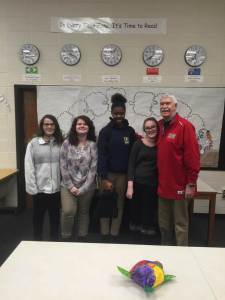
For as exciting as this method of PBL learning is, and it’s clear that it’s starting to work; students and teachers on the whole are more engaged in their study areas… it’s not without it’s challenges. One of the biggest cited in the report is that not all of the teachers have bought into the STEAM /PBL concept. This makes communicating those ideas to students that much harder. Further professional development is needed in order to ensure more participation by teachers. They have also had some difficulty setting up model classrooms so we are hoping teachers observing other teachers will assist in this. But as more teachers undergo professional development and find the merit in this method of teaching the easier it will get. And year two has some exciting things in store for the students. One word: Robots. We look forward to hearing about their experiences with Robots.
How might Robots, cross-cultural references and civil rights intersect?
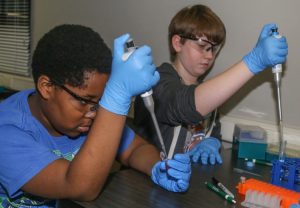
Let’s mix up that engineering and art a bit, shall we? The term “robot” came from a Czech play called Rossums Universal Robots and is derived from the word “robotnik” which means slave. It’s about a robot who is forced to work for a shady company that then rebels and leads to the extinction of the human race. It’s bleak, but not without hope. But it’s a good lesson and a challenge for students on how we should be thinking about a newly created servant class. Just some food for thought.
Learn more
- STEAM, not STEM
- STEAM Rising: Why we need to put the arts into STEM education
- Project-Based Learning: PBL is a dynamic classroom approach in which students actively explore real-world problems and challenges and acquire a deeper knowledge
- Project-Based Learning: Students actively investigate solutions to complex, long-term challenges, often in groups
Teacher Collaboration Creates Real World Learning and Assessment at San Francisco Community School

Collaborative Planning for Project Based Learning
Teaching, despite being surrounded by literally hundreds of human beings on a daily basis, can be a very isolating profession. An educator could be likened to being a single island in an archipelago. While they are a part of an entity larger than themselves the vast gulfs that separate them keep them from fully benefitting from each other’s resources. Coupled with the daily slog through textbooks, homework, and testing, it’s easy to see how a teacher’s passion for education could wane. Is collaboration with other teachers a way to improve teaching and learning? The educators at San Francisco Community School (SFC) proposed exactly that in the Collaborative Planning for Project Based Learning project funded by McCarthey Dressman Education Foundation.
What exactly is Project Based Learning (PBL)?
According to the Buck Institute for Education PBL is “a teaching method in which students gain knowledge and skills by working for an extended period of time to investigate and respond to a complex question, problem, or challenge.” You can learn more about types of PBL from John Larmer at Edutopia. Put more simply, it’s learning by doing. PBL is a model that shifts its focus away from a teacher-centric approach and emphasizes student directed assignments. With a focus on relevant assessment and real world relevance, PBL is a very exciting alternative for both students and teachers to traditional classroom learning.

What are the benefits of PBL for teachers and students?
According to the National Education Administration, PBL “makes learning relevant to students by establishing connections to life outside the classroom and addressing real world issues. In the classroom PBL gives teachers an opportunity to build relationships with students by acting as their coach, facilitator, and co-learner.” In the past few years the increased access to technology in schools, even underprivileged ones like SFC, makes this type of learning much more accessible. The large format of the projects also lend themselves to being easily shared between teachers and with parents who are invested in the student’s learning process.
How are the educators at SFC implementing PBL?
It’s not an easy approach, especially if you have limited resources and time. According to the original proposal by Jessica Fishman, who is spearheading the project, “The Collaborative Planning Project (CPP) will allow SFC teachers to work together for three days in summer study groups to establish essential learning objectives, develop long-term project-based curriculum and develop common learning strategies for the coming year.”

The teachers used the text Understanding by Design by Wiggins & McTighe as their guide as they work through the ideas of backwards design and the building blocks of project based learning. The teachers were also be divided into groups based on grade ranges so that, when sharing, they could manage and engage each others needs and expectations as students moved through the school. This collaboration will create essential bridges between educators so that ideas and proposals may flow more easily between them.
After two years of implementation, where are they now?
Jessica Fishman was happy to report that the project met or exceeded all the goals they had set.
According to the proposal the goals were as follows:
- Project-based learning methods to support student learning in real-world, meaningful challenge-driven projects.
- Teachers will identify and develop performance-based assessment opportunities and rubrics that are aligned to the projects and indicate the extent to which students have mastered the essential learning outcomes.
- Culturally-relevant instructional strategies designed to engage and support students who are traditionally under-served by public schools.
- Vertical alignment and calibration of expectation and rigor K-8.
By working in their individual grade level groups the teachers created concrete plans for their fall cycle. Not only did they create a solid collaboration plan, they created a set of assessments along with K-8 vertical integration and alignment. The problem they’ve run into both years was that very few teams had time to do initial planning. As a result, many teams were forced to meet again over winter break to finish their planning for the spring. The extra time spent in each others company only strengthened the personal and professional bonds between their educators. Now, with the project plans in place, it’s a much smoother transition for new teachers joining the project.
When teachers are able to truly collaborate it opens up worlds of opportunities, not only for the students, but for the educators as well. There is no reason to cease learning, especially when one is a teacher. The benefits of project based learning are clear, but the added collaboration between educators will only amplify that effect.
Further Reading
CFCO: Service Learning Builds 21st Century Skills, Engages Teens
Connecting lessons learned in classrooms to real world applications is one of the great challenges in teaching. Teachers and administrators at Harrison High School in Evansville, Indiana have come up with an innovative new classroom model to address that challenge.
What is the CFCO?
They have created the Center for Family and Community Outreach (CFCO), which aims to use student skills (built around academic content) to create documents, multimedia, events, presentations, and more for over twenty non-profit organizations in their community.
Educators are able to connect students with members of the non-profit community, creating a symbiotic relationship wherein the student gains valuable real-life skills and the non-profits get a free service. Not only is it easier to engage teenage minds directly if they feel a sense of involvement and contribution towards the betterment of their community, it also helps teens build invaluable skills for the transition into their adult lives.
How can service learning support non-profits and drive engagement for learners?
There are many service learning projects around the country, but few, if any, that drives content in the classroom around producing products for non-profits. The CFCO model has elements of numerous trends in education, such as:

- project-based learning
- student-centered learning
- and new technology,
but is truly innovative for the level of engagement it produces for students.

This program has seven distinct goals.
- Research the non-profit groups and social issues in students’ communities.
- Hold ‘Round Table’ discussions with local experts on special topic issues using the latest online literature and information.
- Tour the non-profit facilities and volunteer with local organizations and events.
- Collaborate with leaders on project ideas and write formal proposals
- Use project based learning and technology to design and create materials
- “Pitch” their ideas through benchmarks and final presentations
- Openly communicate with the community through blogging and video reflections.
Importance of Community Support
Students are immersed in the tangible application of skills from the classroom, and since students know what they are doing will have a real impact on their community, it is readily apparent how seriously they take it. The program has relied on a tremendous amount of community support and is currently in it’s third year of operation. Fortunately they continue to draw in new non-profit partners based on the satisfaction of their initial partners and publicity the projects have generated for the mission of non-profits in Evansville.
What is the impact?
So where are the teachers and students of Harrison High School now, a year into the program? Reports have come back with very positive results, including:
- Students have a sense of ownership and engagement in their work as well as their community.
- Non-profit data shows that the community’s organizations have much higher perception of the schools and teens’ abilities after working with the CFCO.
Moving forward they plan on moving the program to a half day model, to increase student exposure, as well as continuing to nurture community involvement and contribution.

With such an easily adaptable model, educators around the country should be looking to Evansville, and Harrison High School in particular. How they proceed could very well dictate how dozens of similar programs pop up in the future. Community involvement and concrete links between lessons learned in the classroom and real world applications are key in both advancing education as well as building a student body that is invested in the present and future of their community. While the saying “It takes a village to raise a child,” has been politicized as of late, I think we can all agree that fostering a child’s investment and involvement in his or her village can only lead to positive results.
For more information
Related articles
- NSSE Results 2013 (teachingresearcher.wordpress.com)
- Creating Space for Marginalized Voices: Re-focusing Service Learning on Community Change and Social Justice (knrajlibrary.wordpress.com)
- Online Student is Set on ReStore-ing Ethics (blogs.msbcollege.edu)

